LAWS2301 Company Law Assignment: Director Duties and Remedies
VerifiedAdded on 2022/10/31
|9
|1674
|111
Homework Assignment
AI Summary
This assignment solution addresses several issues related to company law, focusing on the roles and responsibilities of directors and officers within a corporation. Part A examines the potential removal of Hilary as managing director and her liabilities, referencing the Corporations Act 2001. Part B assesses the prospects of amending the company's constitution, considering the impact on shareholder rights. Part C explores potential civil or criminal remedies against Ben for misuse of power, citing relevant sections of the Act and case law like ASIC v Vizard. Finally, Part D investigates actions against Eric for breaching his duties and available remedies for Silver, referencing the duty of care and diligence outlined in section 180 of the Act and the case of Vrisakis v Australian Securities Commission. The assignment provides legal analysis and conclusions based on the provided facts and relevant legislation and case law.
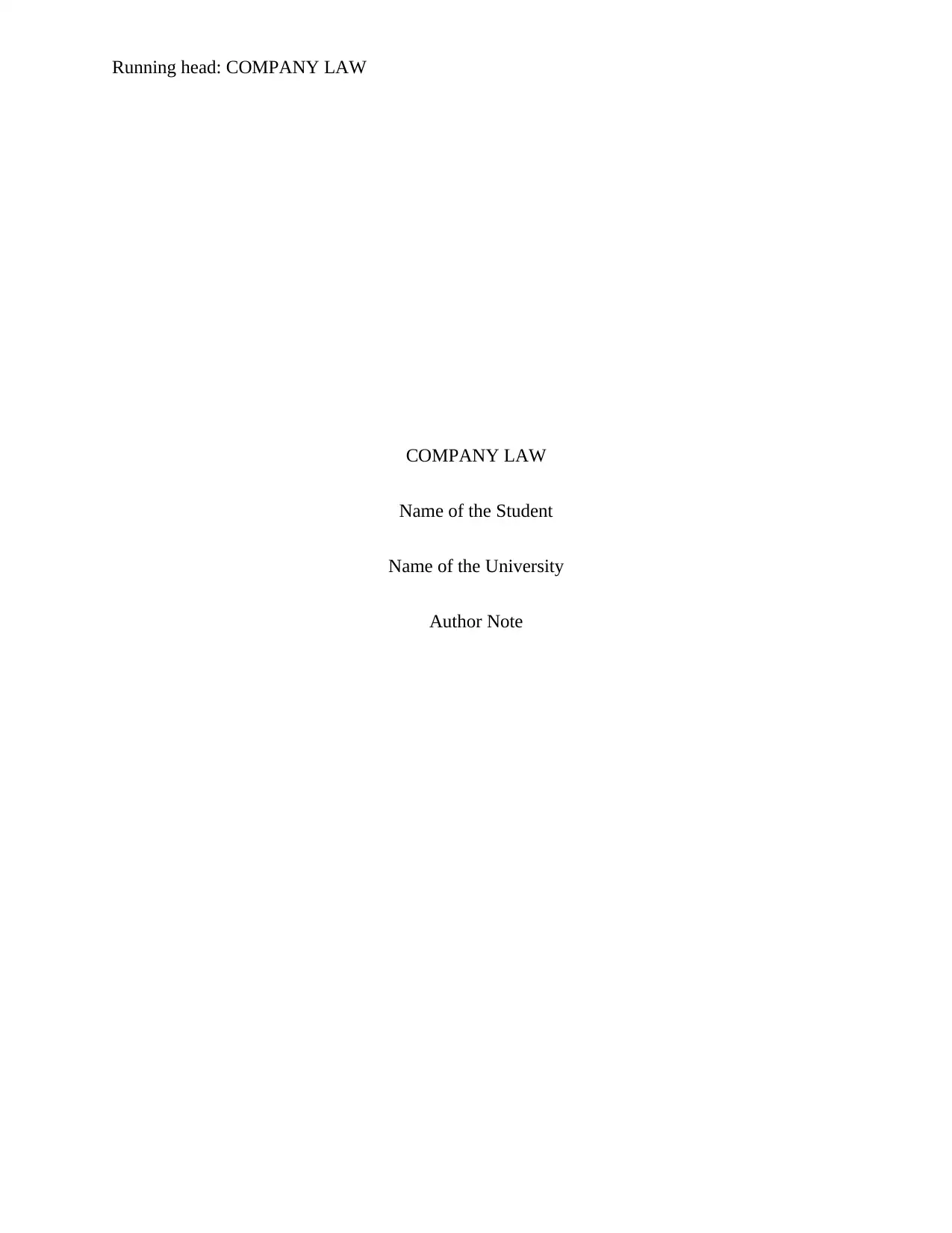
Running head: COMPANY LAW
COMPANY LAW
Name of the Student
Name of the University
Author Note
COMPANY LAW
Name of the Student
Name of the University
Author Note
Paraphrase This Document
Need a fresh take? Get an instant paraphrase of this document with our AI Paraphraser
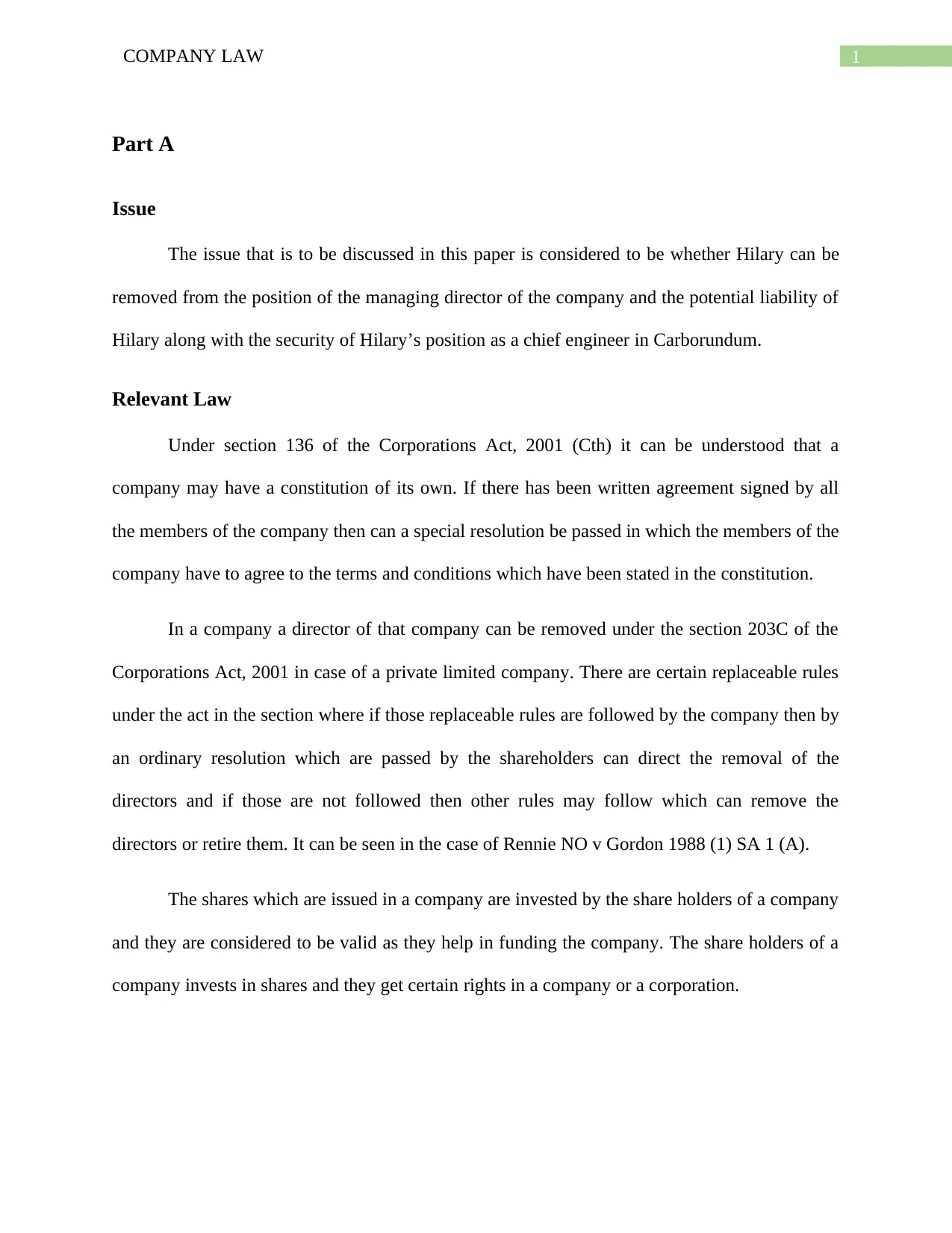
1COMPANY LAW
Part A
Issue
The issue that is to be discussed in this paper is considered to be whether Hilary can be
removed from the position of the managing director of the company and the potential liability of
Hilary along with the security of Hilary’s position as a chief engineer in Carborundum.
Relevant Law
Under section 136 of the Corporations Act, 2001 (Cth) it can be understood that a
company may have a constitution of its own. If there has been written agreement signed by all
the members of the company then can a special resolution be passed in which the members of the
company have to agree to the terms and conditions which have been stated in the constitution.
In a company a director of that company can be removed under the section 203C of the
Corporations Act, 2001 in case of a private limited company. There are certain replaceable rules
under the act in the section where if those replaceable rules are followed by the company then by
an ordinary resolution which are passed by the shareholders can direct the removal of the
directors and if those are not followed then other rules may follow which can remove the
directors or retire them. It can be seen in the case of Rennie NO v Gordon 1988 (1) SA 1 (A).
The shares which are issued in a company are invested by the share holders of a company
and they are considered to be valid as they help in funding the company. The share holders of a
company invests in shares and they get certain rights in a company or a corporation.
Part A
Issue
The issue that is to be discussed in this paper is considered to be whether Hilary can be
removed from the position of the managing director of the company and the potential liability of
Hilary along with the security of Hilary’s position as a chief engineer in Carborundum.
Relevant Law
Under section 136 of the Corporations Act, 2001 (Cth) it can be understood that a
company may have a constitution of its own. If there has been written agreement signed by all
the members of the company then can a special resolution be passed in which the members of the
company have to agree to the terms and conditions which have been stated in the constitution.
In a company a director of that company can be removed under the section 203C of the
Corporations Act, 2001 in case of a private limited company. There are certain replaceable rules
under the act in the section where if those replaceable rules are followed by the company then by
an ordinary resolution which are passed by the shareholders can direct the removal of the
directors and if those are not followed then other rules may follow which can remove the
directors or retire them. It can be seen in the case of Rennie NO v Gordon 1988 (1) SA 1 (A).
The shares which are issued in a company are invested by the share holders of a company
and they are considered to be valid as they help in funding the company. The share holders of a
company invests in shares and they get certain rights in a company or a corporation.
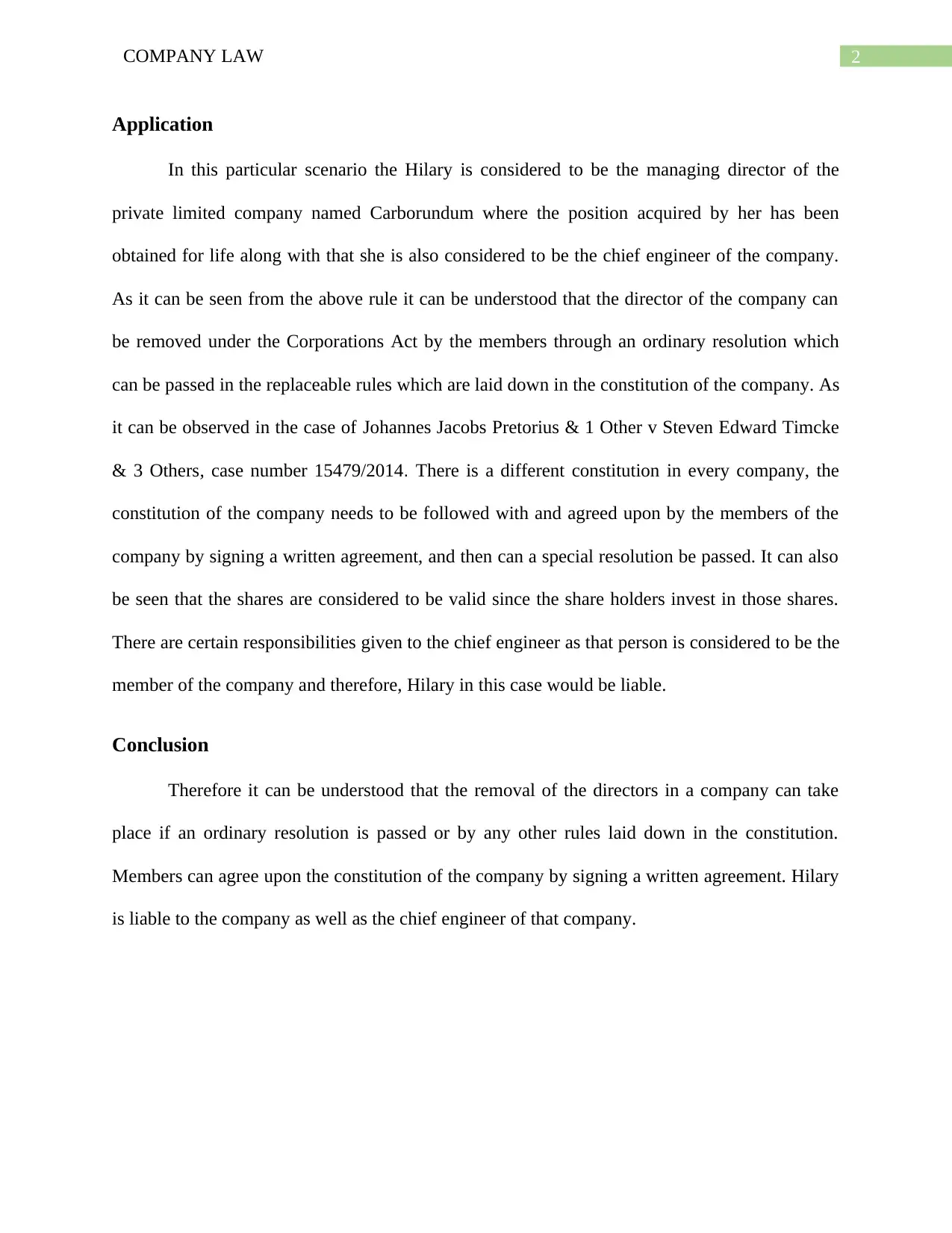
2COMPANY LAW
Application
In this particular scenario the Hilary is considered to be the managing director of the
private limited company named Carborundum where the position acquired by her has been
obtained for life along with that she is also considered to be the chief engineer of the company.
As it can be seen from the above rule it can be understood that the director of the company can
be removed under the Corporations Act by the members through an ordinary resolution which
can be passed in the replaceable rules which are laid down in the constitution of the company. As
it can be observed in the case of Johannes Jacobs Pretorius & 1 Other v Steven Edward Timcke
& 3 Others, case number 15479/2014. There is a different constitution in every company, the
constitution of the company needs to be followed with and agreed upon by the members of the
company by signing a written agreement, and then can a special resolution be passed. It can also
be seen that the shares are considered to be valid since the share holders invest in those shares.
There are certain responsibilities given to the chief engineer as that person is considered to be the
member of the company and therefore, Hilary in this case would be liable.
Conclusion
Therefore it can be understood that the removal of the directors in a company can take
place if an ordinary resolution is passed or by any other rules laid down in the constitution.
Members can agree upon the constitution of the company by signing a written agreement. Hilary
is liable to the company as well as the chief engineer of that company.
Application
In this particular scenario the Hilary is considered to be the managing director of the
private limited company named Carborundum where the position acquired by her has been
obtained for life along with that she is also considered to be the chief engineer of the company.
As it can be seen from the above rule it can be understood that the director of the company can
be removed under the Corporations Act by the members through an ordinary resolution which
can be passed in the replaceable rules which are laid down in the constitution of the company. As
it can be observed in the case of Johannes Jacobs Pretorius & 1 Other v Steven Edward Timcke
& 3 Others, case number 15479/2014. There is a different constitution in every company, the
constitution of the company needs to be followed with and agreed upon by the members of the
company by signing a written agreement, and then can a special resolution be passed. It can also
be seen that the shares are considered to be valid since the share holders invest in those shares.
There are certain responsibilities given to the chief engineer as that person is considered to be the
member of the company and therefore, Hilary in this case would be liable.
Conclusion
Therefore it can be understood that the removal of the directors in a company can take
place if an ordinary resolution is passed or by any other rules laid down in the constitution.
Members can agree upon the constitution of the company by signing a written agreement. Hilary
is liable to the company as well as the chief engineer of that company.
⊘ This is a preview!⊘
Do you want full access?
Subscribe today to unlock all pages.

Trusted by 1+ million students worldwide
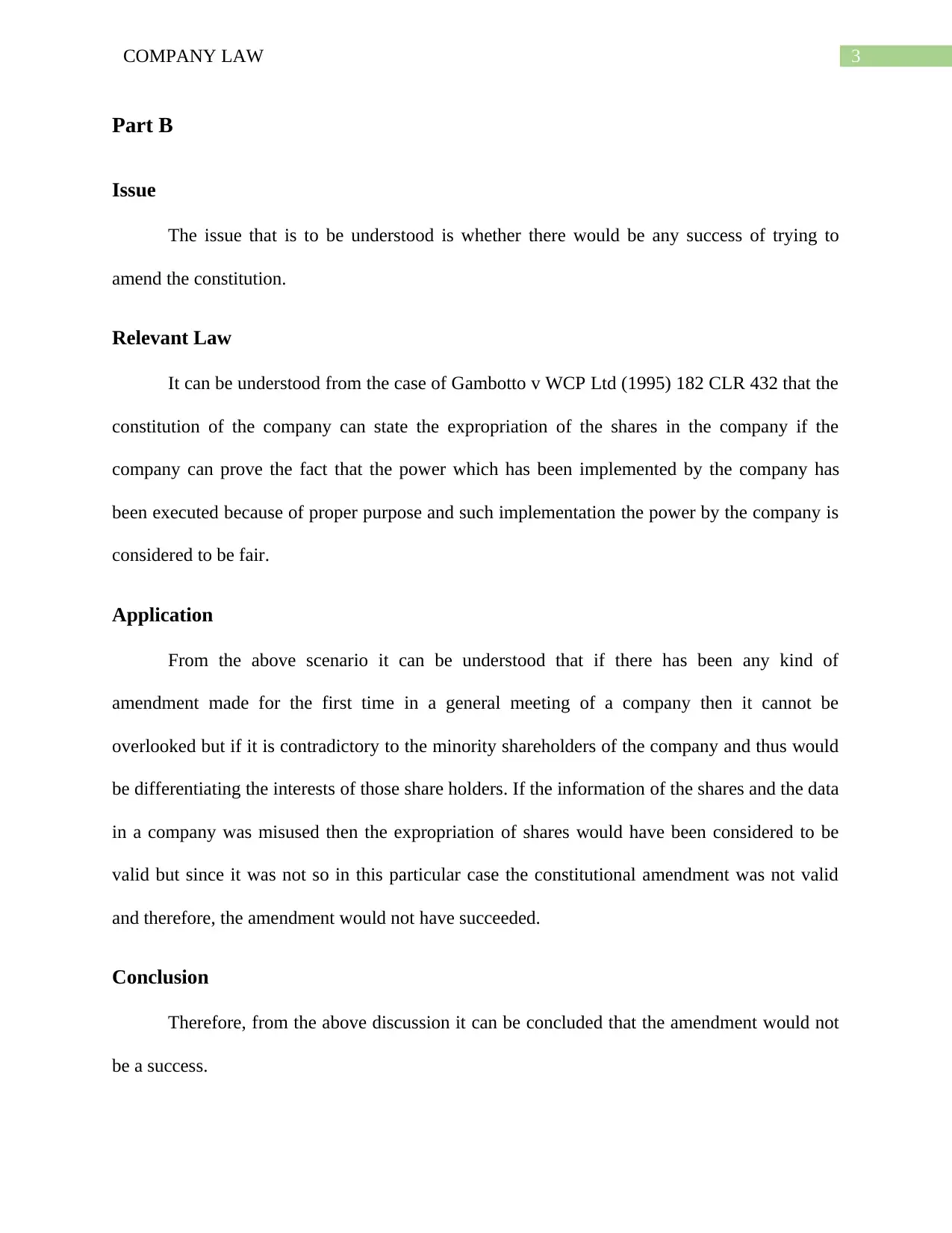
3COMPANY LAW
Part B
Issue
The issue that is to be understood is whether there would be any success of trying to
amend the constitution.
Relevant Law
It can be understood from the case of Gambotto v WCP Ltd (1995) 182 CLR 432 that the
constitution of the company can state the expropriation of the shares in the company if the
company can prove the fact that the power which has been implemented by the company has
been executed because of proper purpose and such implementation the power by the company is
considered to be fair.
Application
From the above scenario it can be understood that if there has been any kind of
amendment made for the first time in a general meeting of a company then it cannot be
overlooked but if it is contradictory to the minority shareholders of the company and thus would
be differentiating the interests of those share holders. If the information of the shares and the data
in a company was misused then the expropriation of shares would have been considered to be
valid but since it was not so in this particular case the constitutional amendment was not valid
and therefore, the amendment would not have succeeded.
Conclusion
Therefore, from the above discussion it can be concluded that the amendment would not
be a success.
Part B
Issue
The issue that is to be understood is whether there would be any success of trying to
amend the constitution.
Relevant Law
It can be understood from the case of Gambotto v WCP Ltd (1995) 182 CLR 432 that the
constitution of the company can state the expropriation of the shares in the company if the
company can prove the fact that the power which has been implemented by the company has
been executed because of proper purpose and such implementation the power by the company is
considered to be fair.
Application
From the above scenario it can be understood that if there has been any kind of
amendment made for the first time in a general meeting of a company then it cannot be
overlooked but if it is contradictory to the minority shareholders of the company and thus would
be differentiating the interests of those share holders. If the information of the shares and the data
in a company was misused then the expropriation of shares would have been considered to be
valid but since it was not so in this particular case the constitutional amendment was not valid
and therefore, the amendment would not have succeeded.
Conclusion
Therefore, from the above discussion it can be concluded that the amendment would not
be a success.
Paraphrase This Document
Need a fresh take? Get an instant paraphrase of this document with our AI Paraphraser
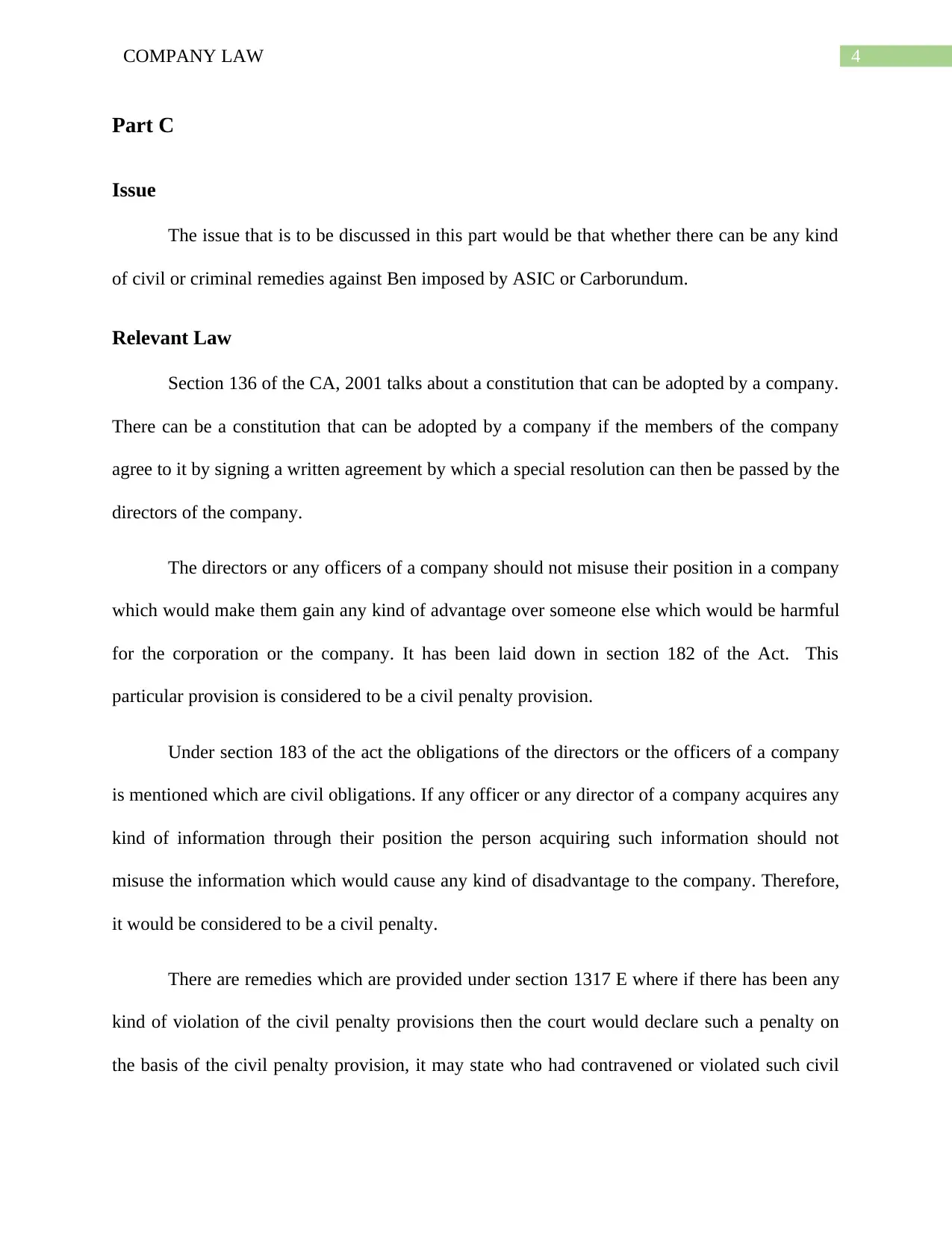
4COMPANY LAW
Part C
Issue
The issue that is to be discussed in this part would be that whether there can be any kind
of civil or criminal remedies against Ben imposed by ASIC or Carborundum.
Relevant Law
Section 136 of the CA, 2001 talks about a constitution that can be adopted by a company.
There can be a constitution that can be adopted by a company if the members of the company
agree to it by signing a written agreement by which a special resolution can then be passed by the
directors of the company.
The directors or any officers of a company should not misuse their position in a company
which would make them gain any kind of advantage over someone else which would be harmful
for the corporation or the company. It has been laid down in section 182 of the Act. This
particular provision is considered to be a civil penalty provision.
Under section 183 of the act the obligations of the directors or the officers of a company
is mentioned which are civil obligations. If any officer or any director of a company acquires any
kind of information through their position the person acquiring such information should not
misuse the information which would cause any kind of disadvantage to the company. Therefore,
it would be considered to be a civil penalty.
There are remedies which are provided under section 1317 E where if there has been any
kind of violation of the civil penalty provisions then the court would declare such a penalty on
the basis of the civil penalty provision, it may state who had contravened or violated such civil
Part C
Issue
The issue that is to be discussed in this part would be that whether there can be any kind
of civil or criminal remedies against Ben imposed by ASIC or Carborundum.
Relevant Law
Section 136 of the CA, 2001 talks about a constitution that can be adopted by a company.
There can be a constitution that can be adopted by a company if the members of the company
agree to it by signing a written agreement by which a special resolution can then be passed by the
directors of the company.
The directors or any officers of a company should not misuse their position in a company
which would make them gain any kind of advantage over someone else which would be harmful
for the corporation or the company. It has been laid down in section 182 of the Act. This
particular provision is considered to be a civil penalty provision.
Under section 183 of the act the obligations of the directors or the officers of a company
is mentioned which are civil obligations. If any officer or any director of a company acquires any
kind of information through their position the person acquiring such information should not
misuse the information which would cause any kind of disadvantage to the company. Therefore,
it would be considered to be a civil penalty.
There are remedies which are provided under section 1317 E where if there has been any
kind of violation of the civil penalty provisions then the court would declare such a penalty on
the basis of the civil penalty provision, it may state who had contravened or violated such civil
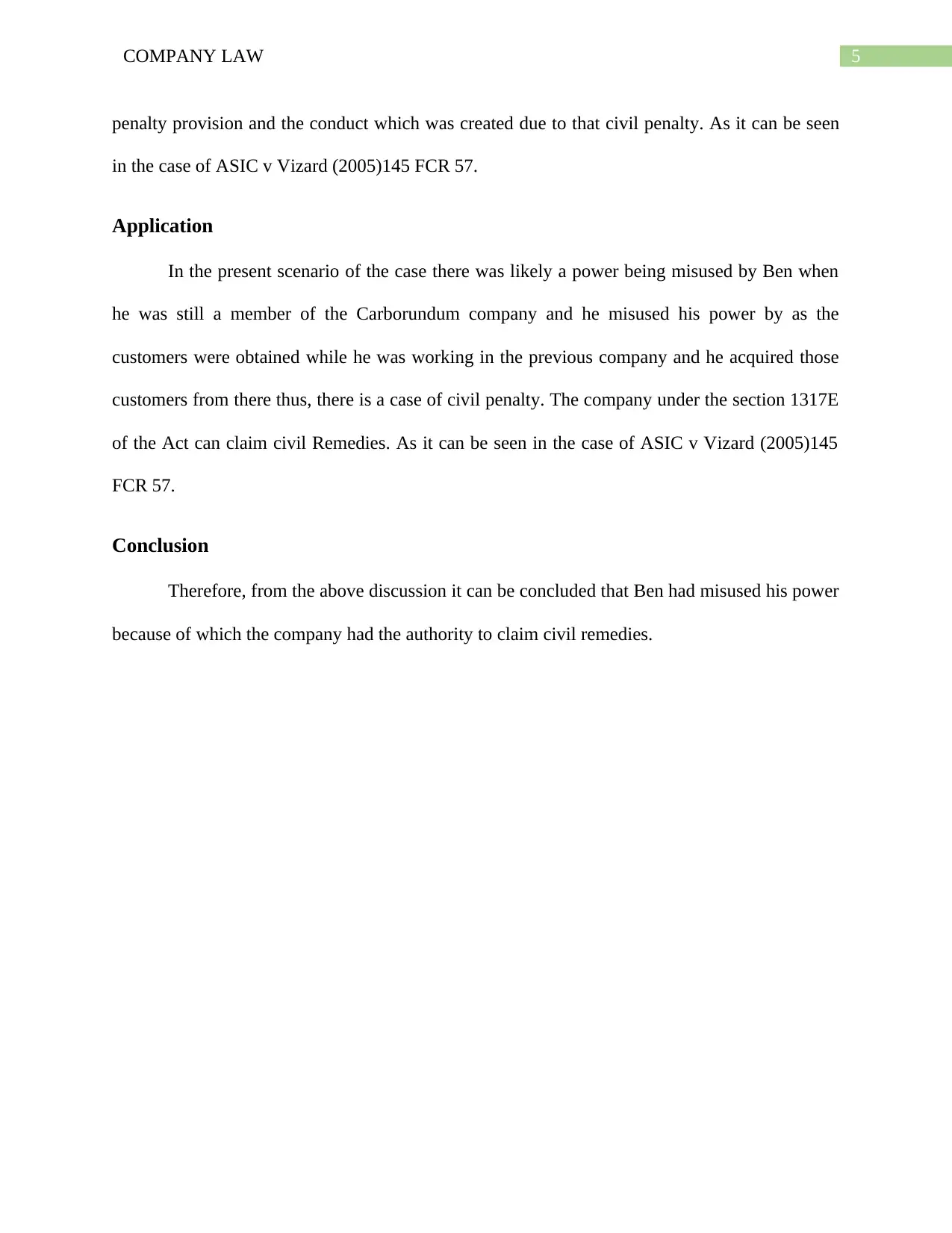
5COMPANY LAW
penalty provision and the conduct which was created due to that civil penalty. As it can be seen
in the case of ASIC v Vizard (2005)145 FCR 57.
Application
In the present scenario of the case there was likely a power being misused by Ben when
he was still a member of the Carborundum company and he misused his power by as the
customers were obtained while he was working in the previous company and he acquired those
customers from there thus, there is a case of civil penalty. The company under the section 1317E
of the Act can claim civil Remedies. As it can be seen in the case of ASIC v Vizard (2005)145
FCR 57.
Conclusion
Therefore, from the above discussion it can be concluded that Ben had misused his power
because of which the company had the authority to claim civil remedies.
penalty provision and the conduct which was created due to that civil penalty. As it can be seen
in the case of ASIC v Vizard (2005)145 FCR 57.
Application
In the present scenario of the case there was likely a power being misused by Ben when
he was still a member of the Carborundum company and he misused his power by as the
customers were obtained while he was working in the previous company and he acquired those
customers from there thus, there is a case of civil penalty. The company under the section 1317E
of the Act can claim civil Remedies. As it can be seen in the case of ASIC v Vizard (2005)145
FCR 57.
Conclusion
Therefore, from the above discussion it can be concluded that Ben had misused his power
because of which the company had the authority to claim civil remedies.
⊘ This is a preview!⊘
Do you want full access?
Subscribe today to unlock all pages.

Trusted by 1+ million students worldwide
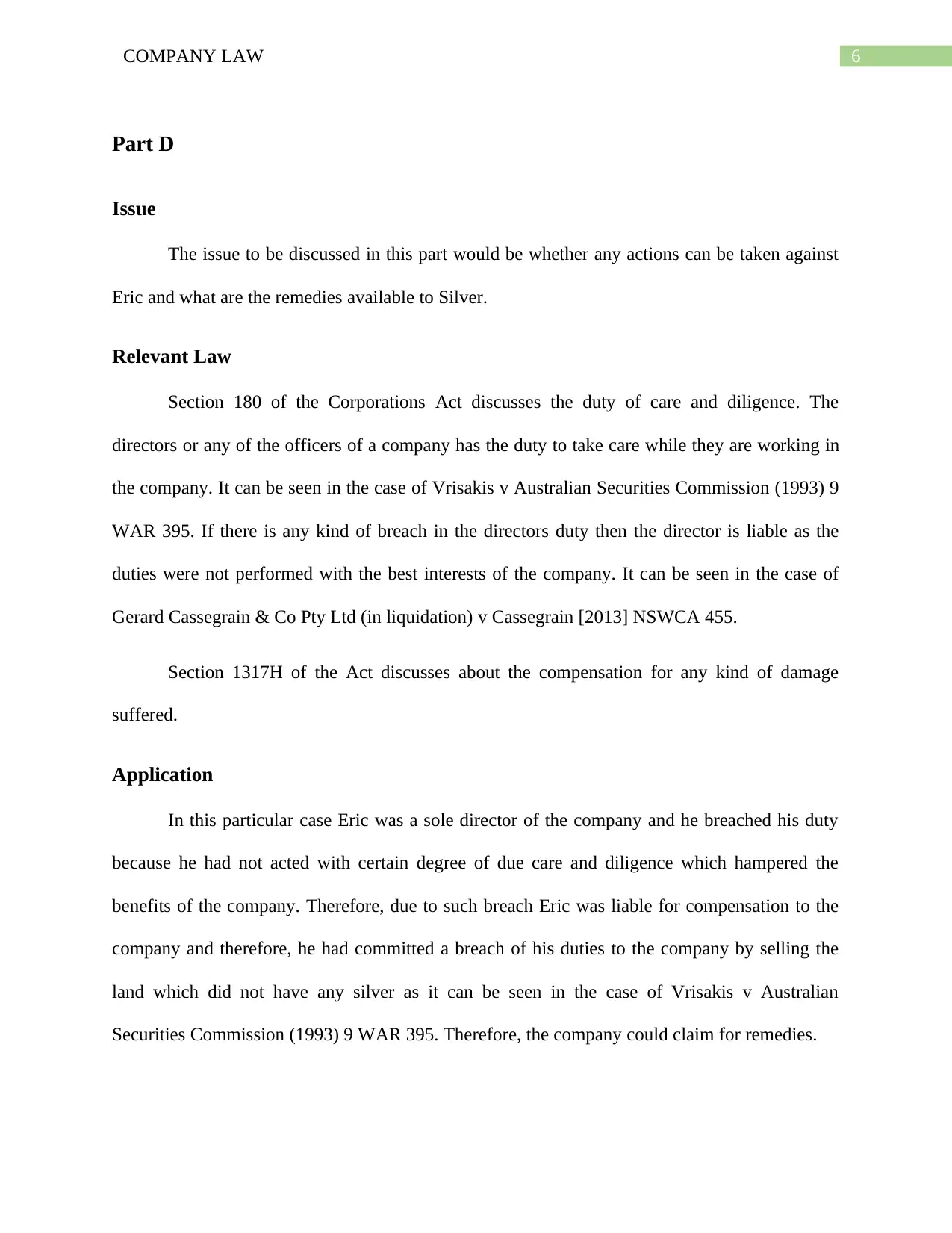
6COMPANY LAW
Part D
Issue
The issue to be discussed in this part would be whether any actions can be taken against
Eric and what are the remedies available to Silver.
Relevant Law
Section 180 of the Corporations Act discusses the duty of care and diligence. The
directors or any of the officers of a company has the duty to take care while they are working in
the company. It can be seen in the case of Vrisakis v Australian Securities Commission (1993) 9
WAR 395. If there is any kind of breach in the directors duty then the director is liable as the
duties were not performed with the best interests of the company. It can be seen in the case of
Gerard Cassegrain & Co Pty Ltd (in liquidation) v Cassegrain [2013] NSWCA 455.
Section 1317H of the Act discusses about the compensation for any kind of damage
suffered.
Application
In this particular case Eric was a sole director of the company and he breached his duty
because he had not acted with certain degree of due care and diligence which hampered the
benefits of the company. Therefore, due to such breach Eric was liable for compensation to the
company and therefore, he had committed a breach of his duties to the company by selling the
land which did not have any silver as it can be seen in the case of Vrisakis v Australian
Securities Commission (1993) 9 WAR 395. Therefore, the company could claim for remedies.
Part D
Issue
The issue to be discussed in this part would be whether any actions can be taken against
Eric and what are the remedies available to Silver.
Relevant Law
Section 180 of the Corporations Act discusses the duty of care and diligence. The
directors or any of the officers of a company has the duty to take care while they are working in
the company. It can be seen in the case of Vrisakis v Australian Securities Commission (1993) 9
WAR 395. If there is any kind of breach in the directors duty then the director is liable as the
duties were not performed with the best interests of the company. It can be seen in the case of
Gerard Cassegrain & Co Pty Ltd (in liquidation) v Cassegrain [2013] NSWCA 455.
Section 1317H of the Act discusses about the compensation for any kind of damage
suffered.
Application
In this particular case Eric was a sole director of the company and he breached his duty
because he had not acted with certain degree of due care and diligence which hampered the
benefits of the company. Therefore, due to such breach Eric was liable for compensation to the
company and therefore, he had committed a breach of his duties to the company by selling the
land which did not have any silver as it can be seen in the case of Vrisakis v Australian
Securities Commission (1993) 9 WAR 395. Therefore, the company could claim for remedies.
Paraphrase This Document
Need a fresh take? Get an instant paraphrase of this document with our AI Paraphraser
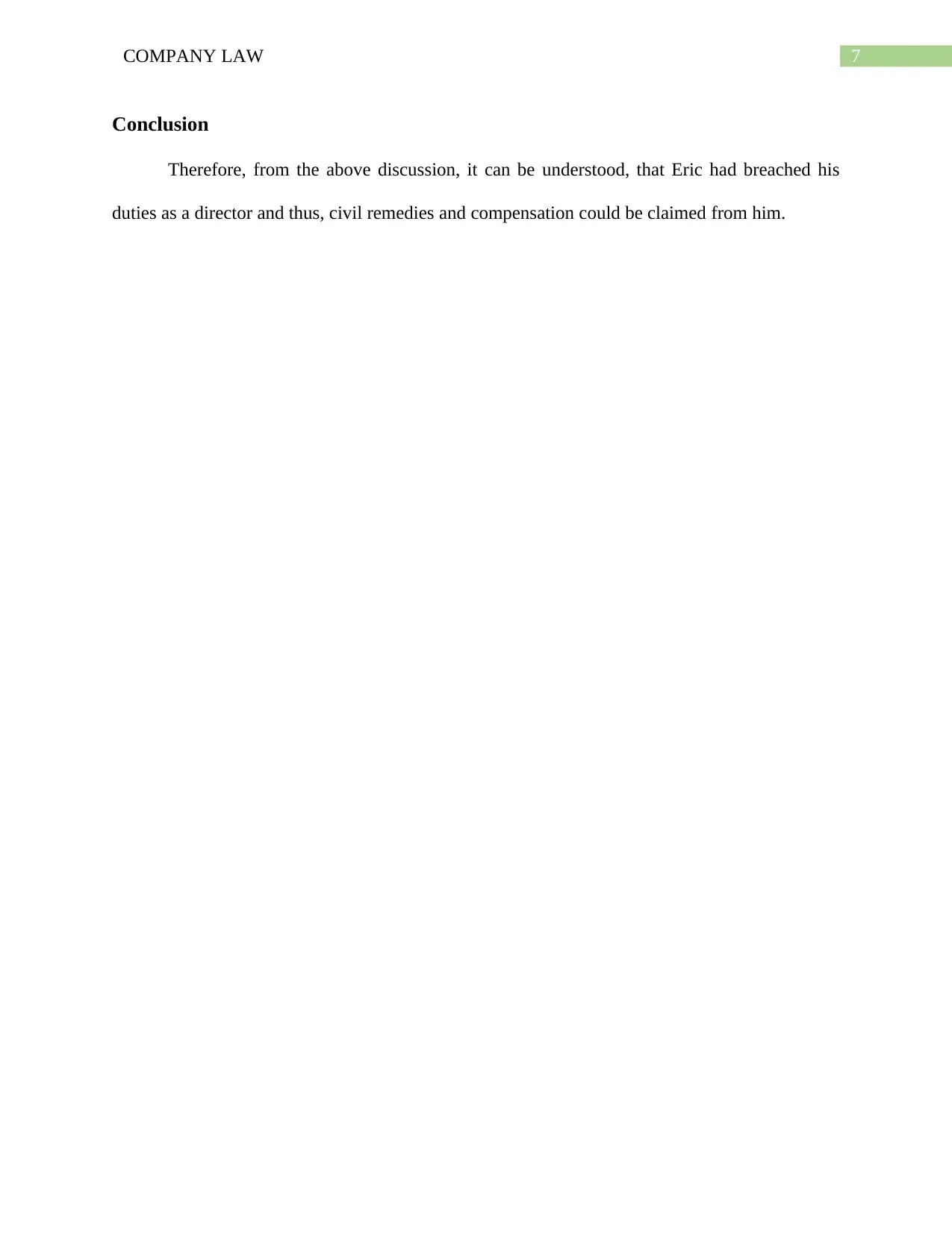
7COMPANY LAW
Conclusion
Therefore, from the above discussion, it can be understood, that Eric had breached his
duties as a director and thus, civil remedies and compensation could be claimed from him.
Conclusion
Therefore, from the above discussion, it can be understood, that Eric had breached his
duties as a director and thus, civil remedies and compensation could be claimed from him.
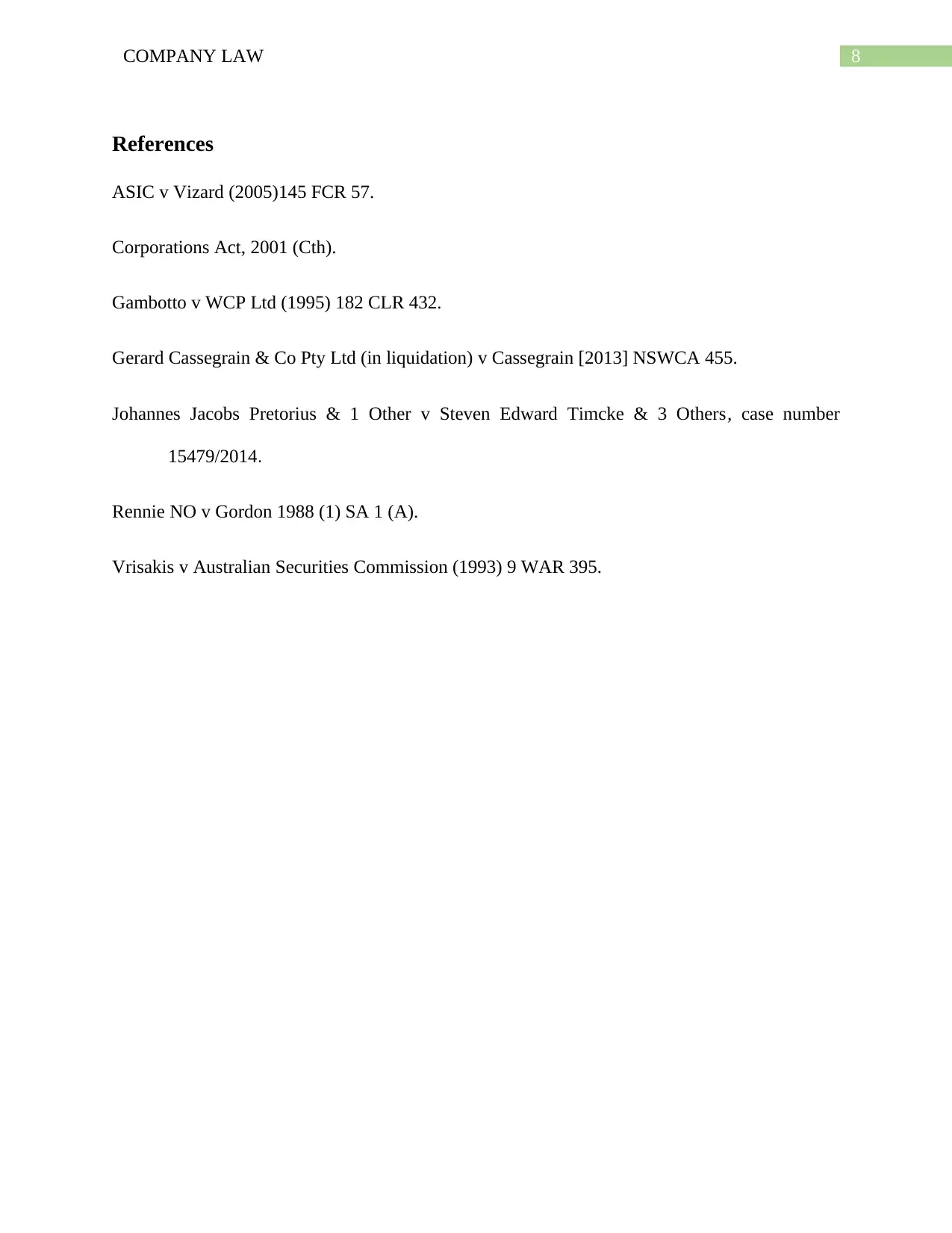
8COMPANY LAW
References
ASIC v Vizard (2005)145 FCR 57.
Corporations Act, 2001 (Cth).
Gambotto v WCP Ltd (1995) 182 CLR 432.
Gerard Cassegrain & Co Pty Ltd (in liquidation) v Cassegrain [2013] NSWCA 455.
Johannes Jacobs Pretorius & 1 Other v Steven Edward Timcke & 3 Others, case number
15479/2014.
Rennie NO v Gordon 1988 (1) SA 1 (A).
Vrisakis v Australian Securities Commission (1993) 9 WAR 395.
References
ASIC v Vizard (2005)145 FCR 57.
Corporations Act, 2001 (Cth).
Gambotto v WCP Ltd (1995) 182 CLR 432.
Gerard Cassegrain & Co Pty Ltd (in liquidation) v Cassegrain [2013] NSWCA 455.
Johannes Jacobs Pretorius & 1 Other v Steven Edward Timcke & 3 Others, case number
15479/2014.
Rennie NO v Gordon 1988 (1) SA 1 (A).
Vrisakis v Australian Securities Commission (1993) 9 WAR 395.
⊘ This is a preview!⊘
Do you want full access?
Subscribe today to unlock all pages.

Trusted by 1+ million students worldwide
1 out of 9
Related Documents
Your All-in-One AI-Powered Toolkit for Academic Success.
+13062052269
info@desklib.com
Available 24*7 on WhatsApp / Email
![[object Object]](/_next/static/media/star-bottom.7253800d.svg)
Unlock your academic potential
Copyright © 2020–2025 A2Z Services. All Rights Reserved. Developed and managed by ZUCOL.





